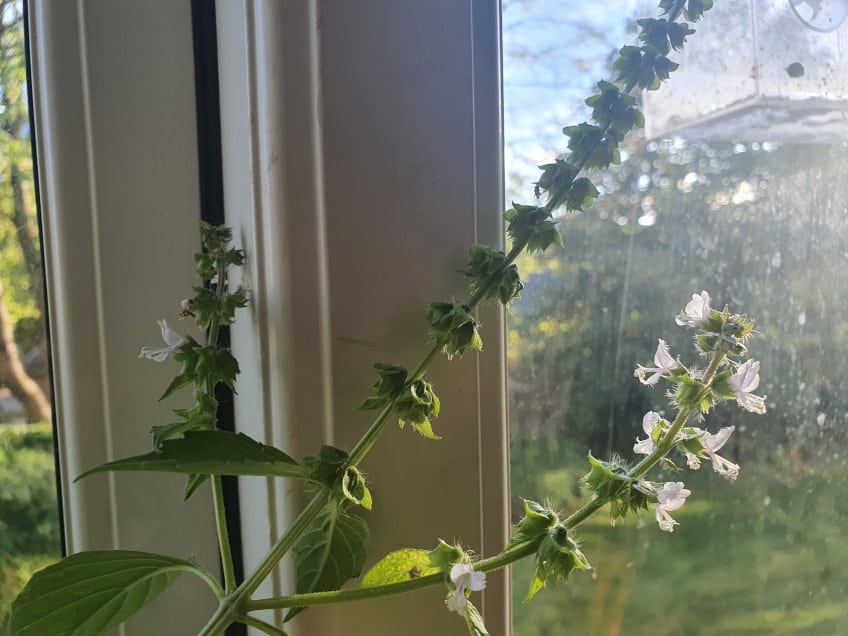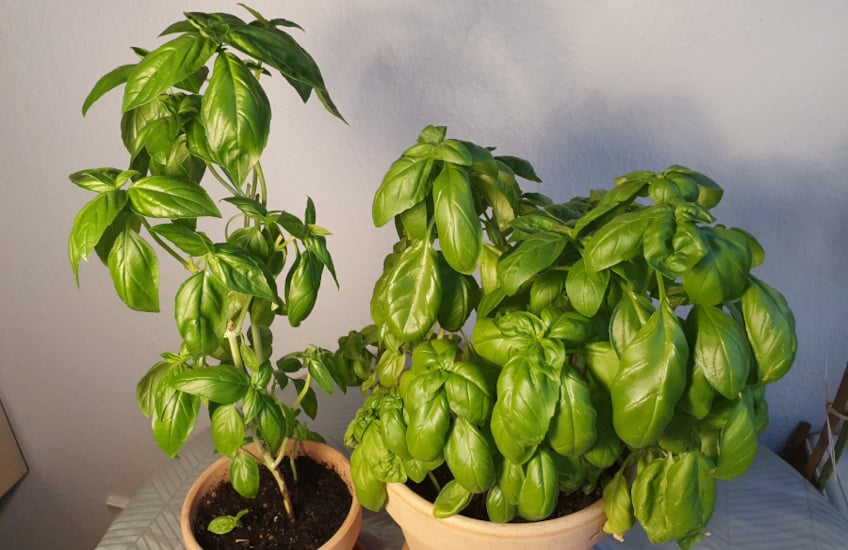This post contains affiliate links.
If taken proper care of, basil will eventually flower, which is the first sign of the plant beginning to produce seeds. One thing that is important to know when growing basil is what you should do when it begins to flower.
Remove basil flowers as soon as they appear to extend the growing period and keep the plant in the production stage. Allowing the plant to flower will cause it to grow slower or stop entirely, but will also attract bees and other pollinators, which can help your garden as a whole.
In this post, I explain when you should and should not remove the flowers from your basil, as well as what the best way to do it is and the benefits of both removing and leaving them. I also describe some of the first signs of flowering so you can be ready and know what to do when it happens.

What to Do When Basil Plants Are Flowering (2 Options)
If your basil is starting to show signs of flowering, you essentially have two options, and while they are both straightforward, you must be prepared and know what you should do.
Basil flowers should be removed as soon as possible if the plant is grown with the purpose of harvesting leaves. However, if the purpose of the basil plant is to harvest seeds, the flowers should not be removed, and the plant should be allowed to go through the entire flowering process.
Most people grow basil for its leaves, and if you are one of those people, you should remove the flowers as soon as you see them. I strongly recommend using pruning shears for that since it helps you make a clean cut which reduces the risk of damaging the plant and allows it to grow back instead.
If you don’t already have pruning shears, these (link to Amazon) are really good. I bought them recently and I am extremely satisfied with them.
If you are growing basil for the leaves, the most important thing you can do is to harvest it correctly and often. Harvesting your basil correctly delays flowering so that you can harvest more overall. I explain how to do that as well as four ways to store it on this link.
Some people like to harvest seeds from their plants, and if that is what you want, just let the flowers be and let the plant go through the process.
Basil flowers are easy to recognize. They are small and can be either purple or white. Here is what they can look like up close.

When basil is flowering, the plant will grow and produce leaves slower than when it is not flowering. This is because the plant shifts its energy from growing to producing flowers and seeds, which is the natural end of its life cycle.
Below, I describe the best and easiest way to remove basil flowers, and at the end of this post, I explain how you can harvest seeds, so if that is what you want, you can skip ahead, but if you are growing basil for the leaves, keep reading.
Best Way to Keep Basil from Flowering
Most basil varieties are annual, meaning their life cycle will be complete within a single growing season. However, some varieties are perennial, which means they keep growing and producing (and flowering) for multiple growing seasons.
Both annual and perennial basil varieties will eventually flower if they are taken proper care of. Whether yours is annual or perennial, it is beneficial to know how to keep your basil from flowering if you want it to continue growing and producing leaves.
The best way to keep basil from flowering is by removing the flowers as soon as they appear, but it can also be beneficial to prune early by cutting stems just above every third set of new leaves. Besides preventing flowering, this also increases the plant’s productivity and makes it more dense and bushy.
The flowers will most likely keep appearing after you remove them since the plant is attempting to produce seeds, but just keep removing the flowers for as long as possible to extend the harvesting season.
If you have 30 seconds (literally), here is a video showing exactly how to remove basil flowers without pruning shears or other tools.
Below, I explain what you should look out for so you can remove the flowers from your basil as early as possible.
First Sign of Basil Flowering

If you are growing basil for the leaves, you can extend the harvesting season by removing the flowers as soon as they appear on the plant, so it is important to know the first signs of flowering.
The first sign that basil is about to flower, is that small flowers begin to form at the center of the newest sets of leaves. It will look very different from the rest of the plant since no actual leaves will grow from where the flowers begin. At first, they are small, but they will quickly grow bigger and taller.
Another sign that basil is flowering is that the growth and production of leaves will slow down significantly. This is because the plant shifts its focus and energy from growing and producing leaves to producing flowers and seeds.
It is also good to know why basil is flowering in the first place, so I get into that below.
What Makes Basil Flower?
If basil is taken proper care of, gets enough direct sunlight, and is watered properly, it will eventually flower.
Basil is usually an annual plant, and flowering is a natural process towards the end of the plant’s life cycle. Flowering is the beginning of seed production. Once basil begins to flower, its energy will be directed toward seed production rather than growing. Once done, the plant generally dies.
Direct sunlight and proper watering are the most important things for basil to grow, and if these conditions are not met, the plant will likely die before even making it to the flowering stage.
As a general rule, basil should get between 6-8 hours of direct sunlight, but it does not need as much during summer as during spring or fall.
When it comes to watering basil, I recommend that you read my article on this link, where I cover everything you should know.
Let Basil Flower if You Want to Collect Seeds

Collecting seeds from your basil is a great way to save money and ensure that you can grow more next year.
Basil seeds are the final result of the flowering process and can be harvested once the flowering process is over. A good rule of thumb for knowing when the seeds can be harvested is to look closely at the plant. Once the plant, including the flowers, starts to dry, the seeds are usually ready.
And here is how you collect them.
Harvest basil seeds by cutting the flowers from the plant and extracting the seeds one by one. Then place the seeds in a dry place for 1-2 weeks to dry them completely. Store the seeds in a dark, dry place until it is time to sow them.
I have a full guide where I explain how to harvest basil seeds on this link where I also explain how to store them correctly.
Basil Can Still Be Used After It Flowers
Your basil might be flowering, but do not worry. You can still use it.
All parts of the basil plant are edible and can be used even after the plant flowers, although the leaves generally become more and more bitter as the plant goes through the flowering process.
In my opinion, the leaves usually taste just fine at the beginning of the flowering process, but as the flowers develop, the leaves become too bitter after some time.
So if your plant is already at a stage where the leaves no longer taste good, there is no point in trying to stop the flowering process, so you might as well let it go to seed, so you can collect the seeds and grow more basil next season. I explain more about this and what else to do with basil at the end of the season in the article on this link.
Basil Flowers Are Edible
Even though you may not want your basil plant to flower, there is at least one positive outcome if (when) it happens, and that is that you get to eat the flowers.
Basil flowers are edible, and they have a distinct but mild flavor of basil that closely resembles that of the leaves, although usually not as strong. Basil flowers can be used in salads or other dishes as a colorful and tasty garnish.
If you are not interested in basil flowers, you can extend the growing stage by removing the flowers as I explained in this article.
Read My Complete Guide to Growing and Caring for Basil
I have written a thorough guide where I cover all parts of growing your own basil including choosing a variety, sowing the seeds, the best growing conditions, pruning, propagation, harvesting, storing, solving various problems, and a lot more. You can find the article on this link.
